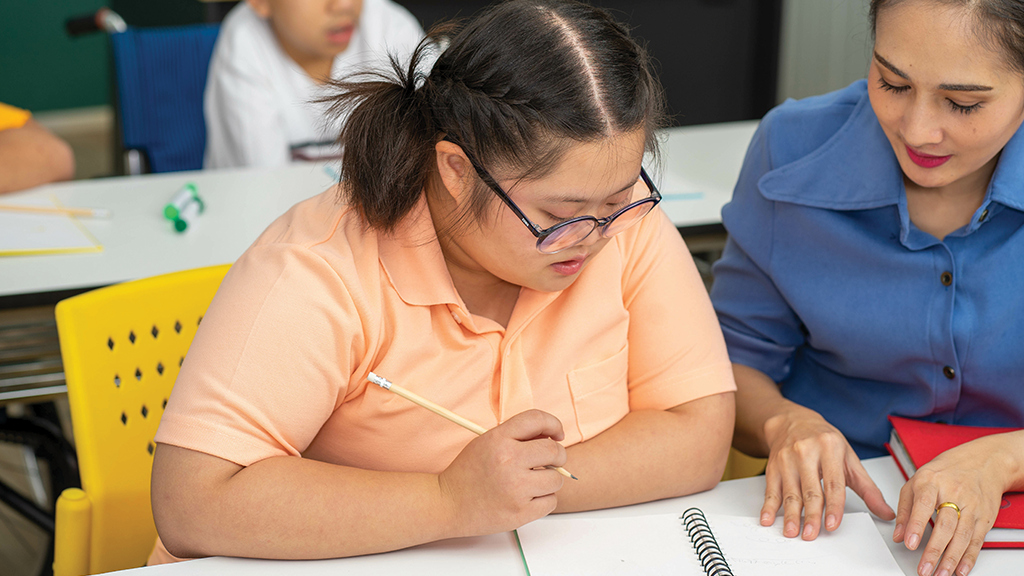
PHOTO CREDIT: AKE/STOCK.ADOBE.COM
Across the U.S., 7.2 million students (15 percent of all students) received special education services during the 2020-21 school year, according to the National Center for Education Statistics, amounting to $77.3 billion annually (an average of $12,474 per student). These students represent all regions, races, genders, ethnicities, and socioeconomic statuses.
We have come a long way since the first special education law was passed in 1975. At that time, any discussion of disability focused on deficits (what students couldn’t do) and carried low expectations for their future. Society viewed disability at any age as “something wrong” with the way those individuals functioned. Like the medical model practiced at the time, special educators were expected to cure or fix the disability so that the student could function like all their “normal” peers.
Today, the most effective educators use a different approach to teaching and learning. They know that “one size fits all” instruction discriminates against most children. They recognize that all children are variable in countless ways (interpersonal differences between them and internal differences in each from day to day). Teachers work collaboratively to make data-based decisions about their students’ individual strengths and needs. They design learning opportunities that reduce barriers to learning and establish the conditions for all children to thrive and learn, including those with disabilities.
The Individuals with Disabilities Education Act (IDEA) was reauthorized in 2004. The purpose of IDEA is “to ensure that all children with disabilities have available to them a free appropriate public education that emphasizes special education and related services designed to meet their unique needs and prepare them for further education, employment, and independent living.” Notice the words in italics. The intent of special education is aligned with the intent we have for all students in public education: Our graduates will be prepared to become fully functioning, responsible and productive citizens. Special education services target each child’s unique needs.
How are we doing? According to the U.S. Department of Labor, the employment of adults with disabilities has flatlined at (or below) 20 percent ever since we started tracking it. Think about it. Of those children we’re teaching now with special education services, only 1 in 5 of them will be employed, and that includes part-time employment and sub-minimum wage employment. These data raise the question: Do we set the same high expectations for students with disabilities that we hold for their typical peers?
The Endrew F. vs. Douglas County U.S. Supreme Court decision of 2017 challenged schools to examine their expectations and practices. There are three implications for students qualifying for special education services:
1. School teams must develop an individualized education plan (IEP) for each student that is “reasonably calculated” to enable the child to make appropriate and ambitious progress in the general education curriculum. That means the interventions and strategies that teachers and specialists implement within their instructional approach must be evidence-based.
2. School teams must evaluate each student’s progress on the IEP and prepare regular reports (usually quarterly) to families with measurable data documenting the extent of the child’s progress. If there is no evidence of “measurable educational benefit,” the team must make changes to the intervention or methodology to improve the child’s outcomes. It is not acceptable for the child to make minimal progress.
3. Families must be involved in meaningful ways in the development of their child’s IEP and in evaluating their child’s progress. As a result, many school districts have launched initiatives aimed at building the capacity of families as partners in the IEP process.
While this Supreme Court decision raised the achievement bar for students with disabilities, a 2004 Wisconsin court case added another requirement. The case involved a student with ADHD who graduated from high school, having earned all high school credits, but he was not successful in either college or employment. The ruling has set a precedent for special education IEP teams across the country.
The IEP team must ensure that the student’s IEP addresses ways that the student’s disability interferes with his progress. Further, the team must establish “graduation criteria” for that individual student, including high school credits and other measures specifically related to that student. Here are three examples where an IEP team has identified an individualized issue that would interfere with a student’s success in school and in their postsecondary future:
A student with ADHD who has difficulty with task completion without adult reminders may need to demonstrate the capacity to self-monitor and complete tasks independently.
A student with emotional disabilities who has difficulty with managing angry outbursts may need to demonstrate that he can self-monitor and deescalate intense feelings.
A student with autism who has difficulty with informal social interactions may need to demonstrate that she can respond appropriately to a social greeting.
All these legal changes require schools to set ambitious expectations for students with disabilities. Underpinning these expectations is a mindset of possibilities, grounded in years of research, that students with disabilities have more assets than deficits, more potential than challenges, and more hope than fears.
Amy M. Pleet-Odle (amy@joyfulinclusion.com) is the owner of Inclusion Focused Coaching, in Elkton, Maryland.

Share this content